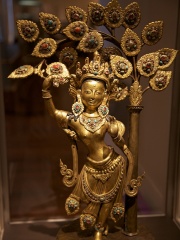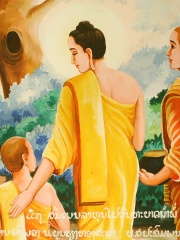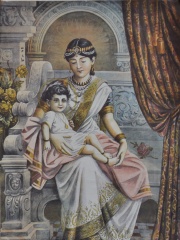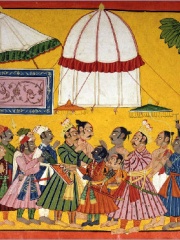




The Most Famous
RELIGIOUS FIGURES from Nepal
This page contains a list of the greatest Nepalese Religious Figures. The pantheon dataset contains 2,238 Religious Figures, 6 of which were born in Nepal. This makes Nepal the birth place of the 48th most number of Religious Figures behind Slovenia and Pakistan.
Top 6
The following people are considered by Pantheon to be the most legendary Nepalese Religious Figures of all time. This list of famous Nepalese Religious Figures is sorted by HPI (Historical Popularity Index), a metric that aggregates information on a biography’s online popularity.

1. Maya (-600 - -600)
With an HPI of 69.19, Maya is the most famous Nepalese Religious Figure. Her biography has been translated into 40 different languages on wikipedia.
Maya (; Devanagari: माया, IAST: māyā), also known as Mahāmāyā and Māyādevī, was the queen of Shakya and the birth mother of Gautama Buddha, the sage on whose teachings Buddhism was founded. She was the wife of Śuddhodana, the king of the Shakya kingdom. She was sister of Mahāpajāpatī Gotamī, the first Buddhist nun ordained by the Buddha. In Buddhist tradition, Maya died soon after the birth of Buddha, generally said to be seven days afterwards, and came to life again in a Buddhist heaven, a pattern that is said to be followed in the births of all Buddhas. Thus Maya did not raise her son who was instead raised by his maternal aunt Mahapajapati Gotami. Maya would, however, on occasion descend from Heaven to give advice to her son. Māyā (माया) means "skillful creator" in Sanskrit. Māyā is also called Mahāmāyā (महामाया, "Great Māyā") and Māyādevī (मायादेवी, "Queen Māyā"). In Chinese, she is known as Móyé-fūrén (摩耶夫人, "Lady Māyā"), in Tibetan she is known as Gyutrulma and in Japanese she is known as Maya-bunin (摩耶夫人). Also, in Sinhalese she is known as මහාමායා දේවී (Mahāmāyā Dēvi).

2. Rāhula (-534 - -500)
With an HPI of 68.57, Rāhula is the 2nd most famous Nepalese Religious Figure. His biography has been translated into 33 different languages.
Rāhula (Pāli and Sanskrit) was the only son of Siddhārtha Gautama (commonly known as the Buddha) (c. 563 or 480 – 483 or 400 BCE), and his wife, princess Yaśodharā. He is mentioned in numerous Buddhist texts, from the early period onward. Accounts about Rāhula indicate a mutual impact between Prince Siddhārtha's life and the lives of his family members. According to the Pāli tradition, Rāhula was born on the day of Prince Siddhārtha's renunciation, and was therefore named Rāhula, meaning a fetter on the path to enlightenment. According to the Mūlasarvāstivāda tradition, and numerous other later sources, however, Rāhula was only conceived on the day of Prince Siddhartha's renunciation, and was born six years later, when Prince Siddhārtha became enlightened as the Buddha. This long gestation period was explained by bad karma from previous lives of both Yaśodharā and of Rāhula himself, although more naturalistic reasons are also given. As a result of the late birth, Yaśodharā needed to prove that Rāhula was really Prince Siddhārtha's son, which she eventually did successfully by an act of truth. Historian H.W. Schumann has argued that Prince Siddhārtha conceived Rāhula and waited for his birth, to be able to leave the palace with the king and queen's permission, but Orientalist Noël Péri considered it more likely that Rāhula was born after Prince Siddhārtha left his palace. 12 years after Rahula's birth, the Buddha returned to his hometown, where Yaśodharā had Rāhula ask the Buddha for the throne of the Śākya clan. The Buddha responded by having Rāhula ordained as the first Buddhist novice monk. He taught the young novice about truth, self-reflection, and not-self, eventually leading to Rāhula's enlightenment. Although early accounts state that Rāhula died before the Buddha did, later tradition has it that Rāhula was one of the disciples that outlived the Buddha, guarding the Buddha's Dispensation until the rising of the next Buddha. Rāhula is known in Buddhist texts for his eagerness for learning, and was honored by novice monks and nuns throughout Buddhist history. His accounts have led to a perspective in Buddhism of seeing children as hindrances to the spiritual life on the one hand, and as people with potential for enlightenment on the other hand.

3. Mahapajapati Gotami (-600 - )
With an HPI of 63.46, Mahapajapati Gotami is the 3rd most famous Nepalese Religious Figure. Her biography has been translated into 28 different languages.
Mahāpajāpatī Gotamī (Pali; Sanskrit: महाप्रजापती गौतमी, Mahāprajāpatī Gautamī) or Pajapati was the foster-mother, step-mother and maternal aunt (mother's sister) of the Buddha. In Buddhist tradition, she was the first woman to seek ordination for women, which she did from Gautama Buddha directly, and she became the first bhikkhuni (Buddhist nun).

4. Janaka ( - )
With an HPI of 58.69, Janaka is the 4th most famous Nepalese Religious Figure. His biography has been translated into 24 different languages.
Janaka was an ancient Hindu king of Videha which was located in Mithila region, approximately in the 8th or 7th century BC. The rulers of the Videha kingdom were called Janakas. He also appears in the epic Ramayana as a father of Sita. His original name was Siradhvaja and he had a brother named Kushadhvaja. His father's name was Hrasvaroman, a descendant of the king Nimi. Janaka is revered as being an ideal example of non-attachment to material possessions. He was intensely interested in spiritual discourse and considered himself free from worldly illusions. His interactions with sages and seekers such as Ashtavakra and Sulabha are recorded in the ancient texts. His relationship with his adopted daughter Sita led her to be called Janaki. The city of Janakpur in Nepal is named after him and his daughter Sita. The Videha (or Mithila) kingdom was historically located between east of Gandaki River, west of Mahananda River, north of the Ganga river and south of the Himalayas.

5. Anuruddha (-450 - )
With an HPI of 53.74, Anuruddha is the 5th most famous Nepalese Religious Figure. His biography has been translated into 19 different languages.
Anuruddha (Pali: Anuruddhā) was one of the ten principal disciples and a cousin of Gautama Buddha.

6. Khagendra Thapa Magar (1992 - 2020)
With an HPI of 34.38, Khagendra Thapa Magar is the 6th most famous Nepalese Religious Figure. His biography has been translated into 22 different languages.
Khagendra Thapa Magar (Nepali: खगेन्द्र थापामगर) (4 October 1992 – 17 January 2020) was a Nepali once known as the shortest man in the world, measuring 0.67 m (2 ft 2 in). Magar, who was a primordial dwarf, won the title of shortest man from Edward Niño Hernández. He lost the title in June 2011 to Junrey Balawing of the Philippines.
Pantheon has 6 people classified as religious figures born between 600 BC and 1992. Of these 6, none of them are still alive today. The most famous deceased religious figures include Maya, Rāhula, and Mahapajapati Gotami.
Deceased Religious Figures
Go to all Rankings
Maya
600 BC - 600 BC
HPI: 69.19
Rāhula
534 BC - 500 BC
HPI: 68.57
Mahapajapati Gotami
600 BC - Present
HPI: 63.46
Janaka
HPI: 58.69
Anuruddha
450 BC - Present
HPI: 53.74
Khagendra Thapa Magar
1992 - 2020
HPI: 34.38






